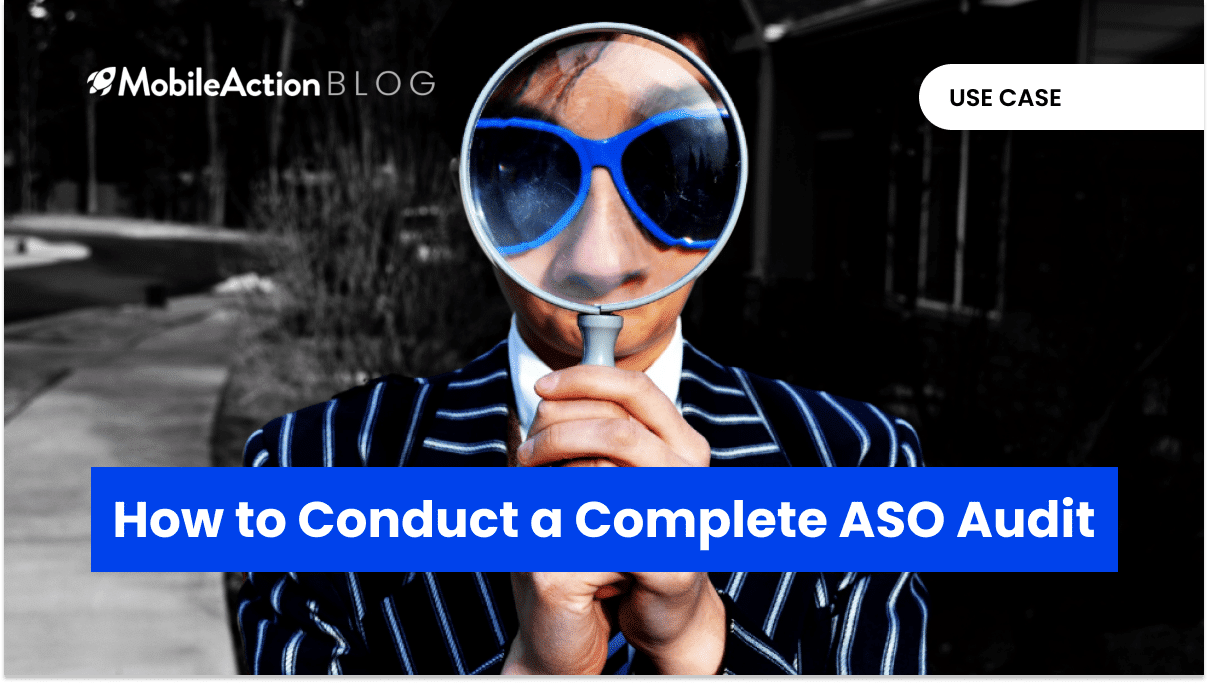With millions of apps in the Google Play Store and the Apple App Store, chances are your app has a lot of tough competition. Your app could be the best one out there, but it wouldn’t succeed without downloads. And for people to download your app, they need to see it. This is where ASO (App Store Optimization) kicks in. By conducting an ASO Audit, you can make sure that your app maintains/increases its visibility.
Most people download apps right after an app store search, which makes App Store Optimization crucial for any app. Therefore, the ranking position of an app will directly affect its number of downloads. Without an ASO strategy, you would be missing out on a significant amount of organic traffic.
Using an ASO tool such as MobileAction will make the process of conducting an ASO Audit much more efficient.
Metadata Optimization
Step 1: Determine your niche and your audience
It is important to understand your audience and to look at your app from their point of view. How would they search for your app? Which keywords would they use to describe it? This is crucial to determine your most important keywords, as they will likely be finding your app through searching for these keywords.
You can start by gathering these keywords on the Keyword Tracking page. Suppose you are the ASO Manager for the Vrbo Vacation Rentals app. We can track generic keywords for this app such as “travel”, “vacation”, “rental”
This will help us understand where we stand, and find more competitors. We can also prioritize these keywords by analyzing their Search Scores and Chance scores. The search score gives us an idea of the search volume of any keyword, and the chance score indicates the possibility of ranking in the top 10 for any keyword. It’s important to target keywords with high search and chance scores to generate more organic traffic.
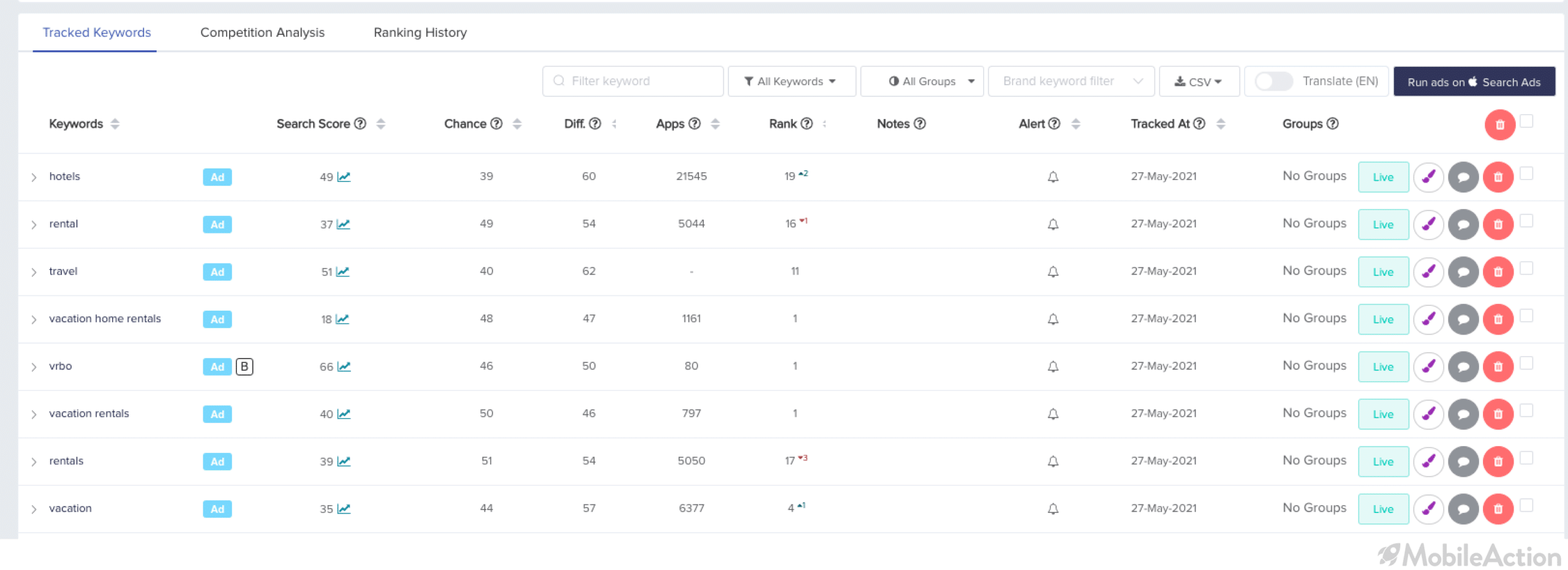
Step 2: Competitor analysis
Checking out Category Rankings to find competitors is pretty intuitive, but there are other ways to discover even more competitors using MobileAction.
Now that you know which keywords you should be targeting, you can use these keywords to determine the apps targeting these keywords, using the Live button and discovering more competitors.
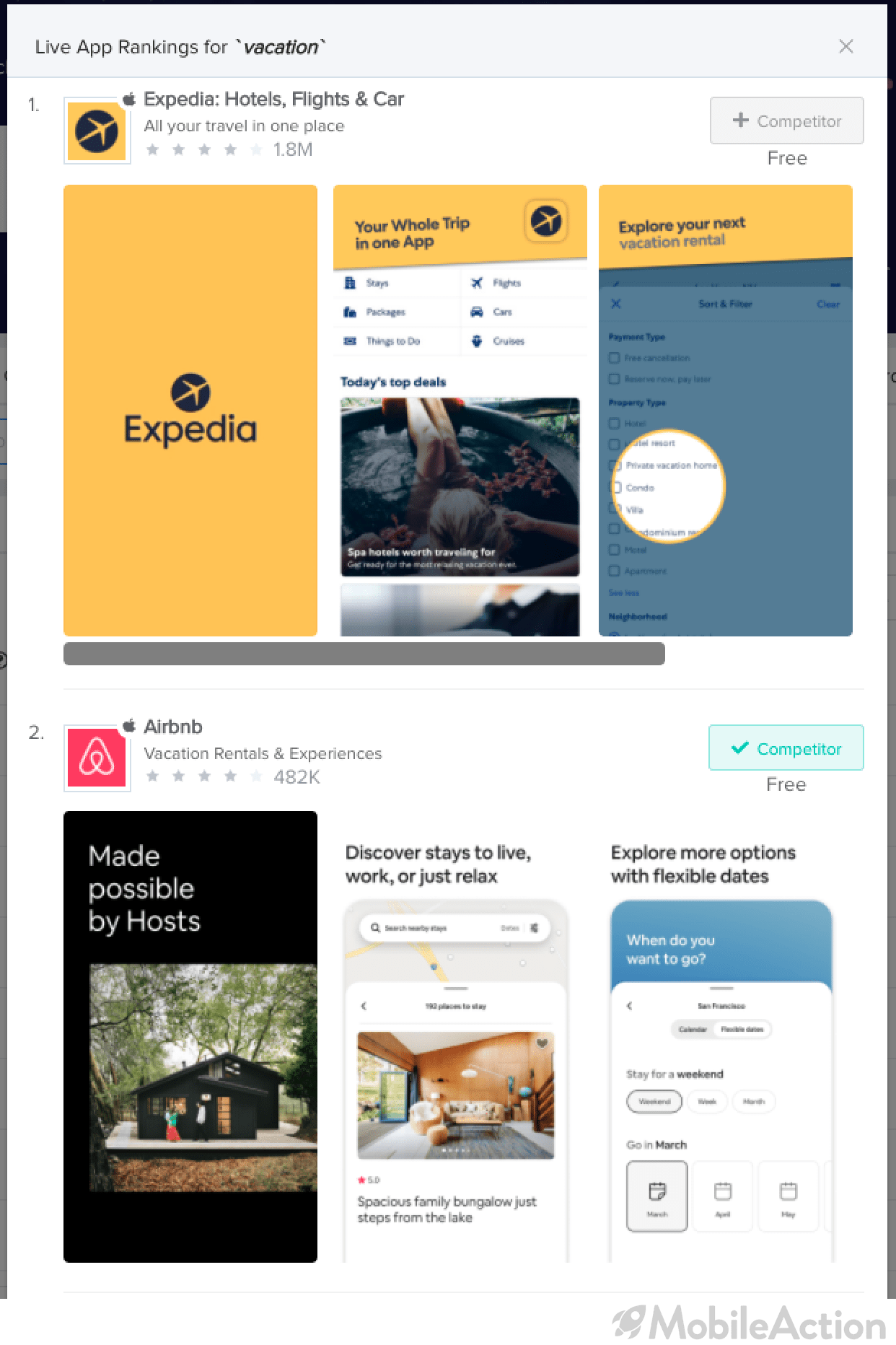
This is a crucial step of the ASO Audit, as it will help you understand your competitors’ strengths and weaknesses so that you can adopt their successful strategies, and avoid their mistakes.
Step 3: Keyword Research
Conducting comprehensive keyword research is an unskippable step before deciding on your metadata. In order to understand which keywords are more popular and which ones are less competitive, you need to have an exhaustive keyword pool.
Using Keyword Spy, we can see all keywords that our competitors have in their metadata, the keywords they are ranking for, and we can directly add these keywords to our keyword pool.
Here, we can see Airbnb’s keywords and track the ones that are relevant for our app. We will be able to see the important metrics for these keywords in the same page, as soon as we track them.

People tend to search for long-tail keywords rather than single generic ones, so it would be beneficial to determine the keywords with higher search volume and more combinations. you will be able to see Apple’s and Google’s autofill suggestions, as well as related keywords with the Keyword Research feature.

We also need to understand which keywords are bringing our competitors organic downloads, so that we can redirect some of that traffic to our app. The Keyword Intelligence feature comes in very handy for this, as it shows exactly that.
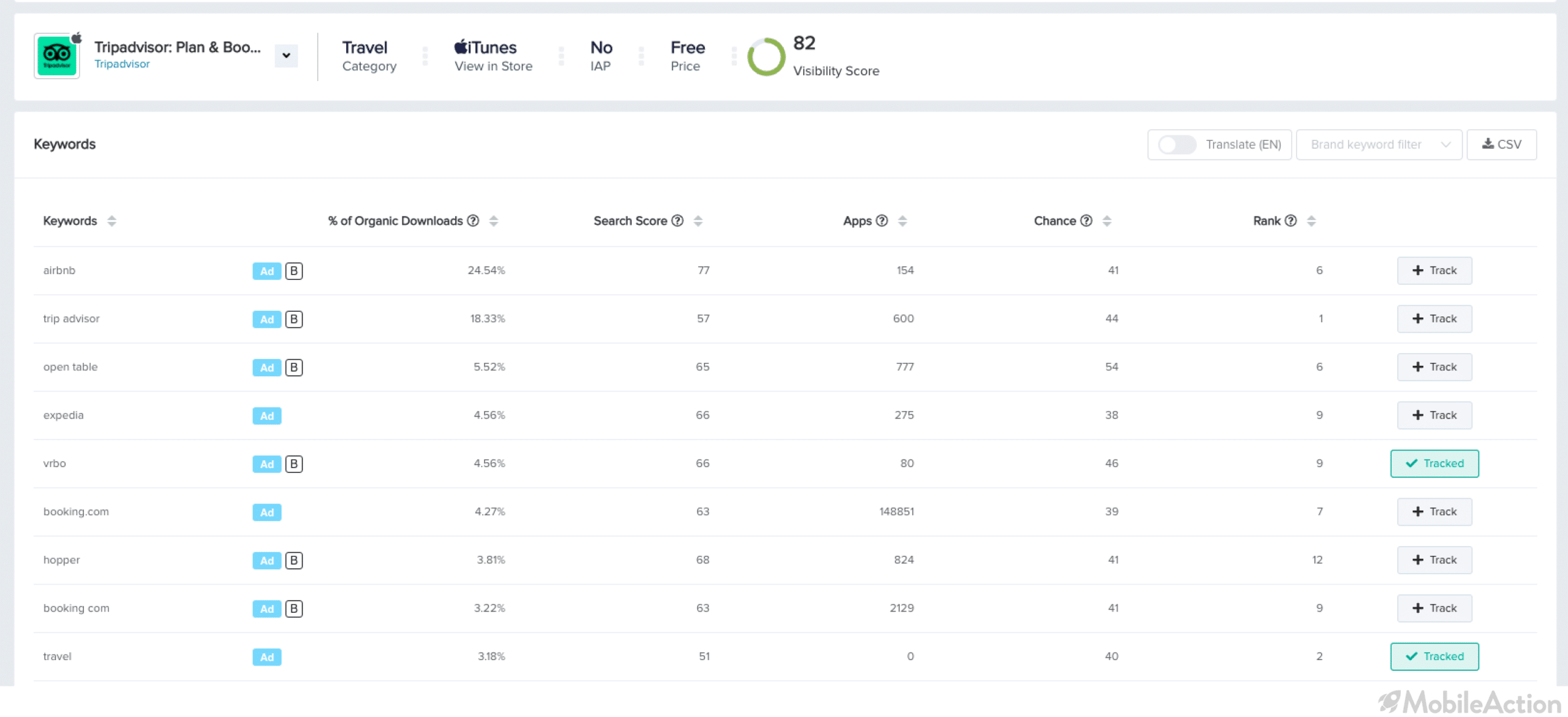
There are many more features that will help you during keyword research in MobileAction, however, using the features mentioned would be a good place to start.
Step 4: Keyword Optimization
Now that you have a comprehensive keyword pool, you need to decide on the right keywords that describe your app and have a good search score. Once you are set on 10-20 keywords from your keyword pool, you can get started with writing your metadata. This step differs in the Apple App Store and the Google Play Store, as different factors will affect your rankings.
In the Apple App Store, the title, subtitle, and keyword list will be indexed. In Google Play Store, the title, short description, and long description are indexed. There are differences in the character limitations in these app stores as well, however, it’s a good practice to make use of these spaces as much as possible in both stores.
Using Keyword Optimization, you can see your keyword pool, your existing metadata, and your competitors’ metadata all in one page to make the decision process easier. Here you can try different variations of your new metadata.

Try to avoid keyword stuffing when you are writing your metadata. This part is tricky as you need to keep the metadata meaningful and cohesive while trying to use all of the keywords you have decided on. You can prioritize by using the most important keywords in the title and leaving the ones disrupting the cohesion in the keyword list for iOS and long descriptions for Android.
Master the Long Description
Now that your app is visible to the right users, you need to convince them to download it. It is vital to make sure your long description draws users in, as it plays a huge role in driving up the conversion rate.
In the Google Play Store, the long description also gets indexed so it would be wise to throw in some of your important keywords. We can analyze long descriptions from the Keyword Optimization feature and compare it with our competitors as well.
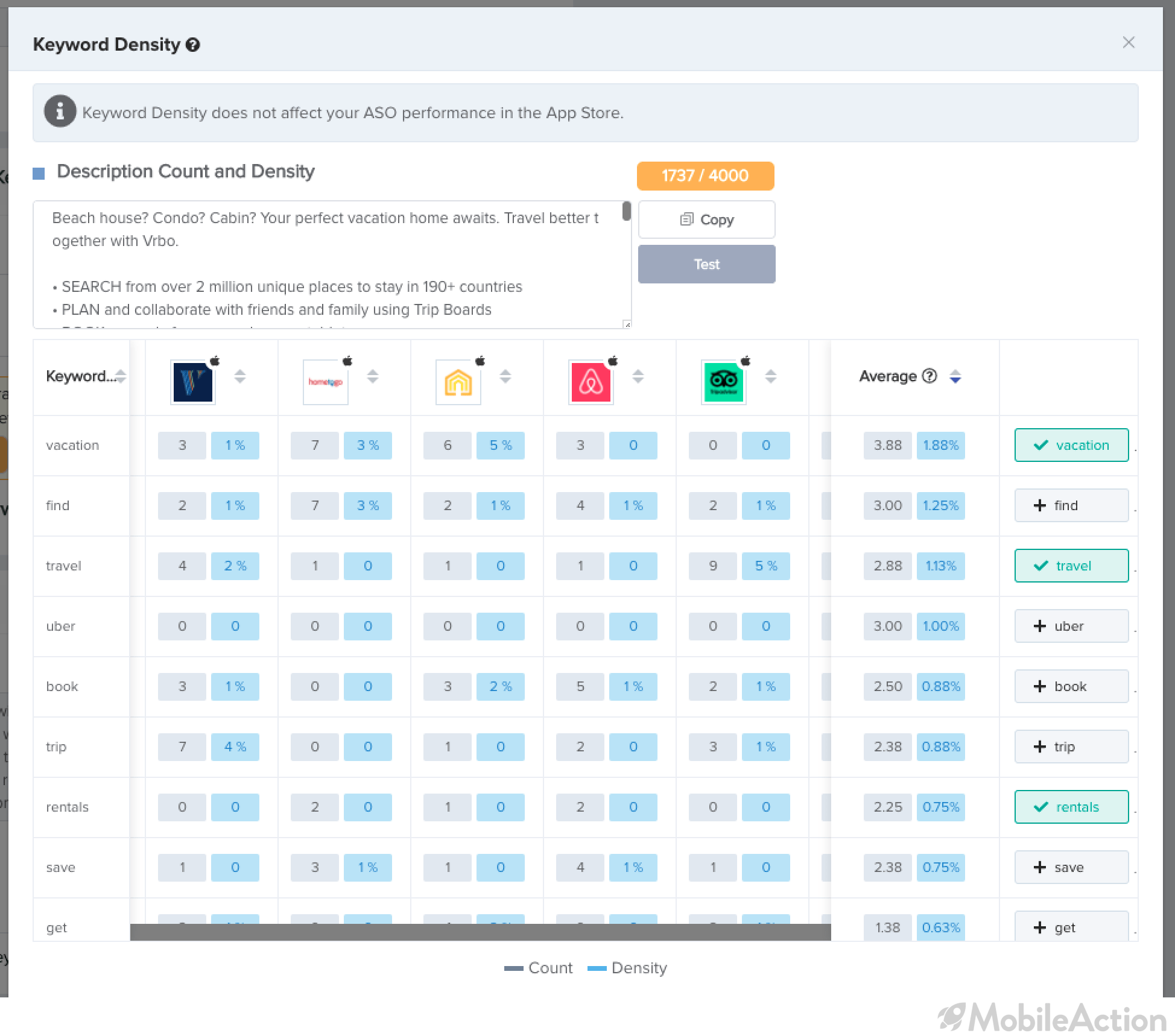
The main goal of a description should be to draw attention to the main value propositions of the app, so your description should tell the reader what your app is about, what makes it unique, and why users should download it.
Try to aim for readability and make sure that your description can be understood by the general audience. You can try different formatting techniques in the Google Play Store by using bullet points and bold titles. If you are unsure about what might work best, A/B testing (Google Play Store only) is your best friend. Do some experiments to understand what draws users in the most.
Manage your Reviews & Ratings
Positive reviews and ratings are crucial to the algorithm and the app’s rankings, which is why it’s vital to have a review and rating management strategy in place. Having better ratings will help your app to be considered more relevant and consequently drive up the rankings.
You can use the Most Mentioned Keyword Analysis in the Reviews feature to get a snapshot of the reviews for any app and get an idea of the users’ thoughts and opinions quickly.

Further than that, the majority of users read at least one review before they download an app, which is why it’s crucial to reply to reviews to signal that you care about their thoughts and feedback.
Optimize your Screenshots
Creative assets are crucial to your app’s success. It can be the first impression that your app has on a user, so you need to make sure that you’re optimizing your creative assets, and you’re doing it right.
When designing your screenshots, the key is to reflect user experience. The decision of whether to use vertical or horizontal screenshots will depend on how your users will be using the app. It’s also crucial to make sure that the flow of the screenshots helps you tell a story and attract the user’s attention.
Another important aspect is making sure that your app icon and screenshots are consistent with each other. The app icon is one of the first things that the users will see when they are going through search results, so it’s important that it captures attention. When designing an icon, less is more. You can do A/B testing (Google Play Store only) with different colors and designs to understand what attracts users more and adapt accordingly.
Check Back and Re-Optimize
Unfortunately, App Store Optimization isn’t a “set in and forget it” practice. The algorithms are ever-changing, and so are your competitors’ practices. To ensure long-term success, you need to treat ASO as a continuous process and do constant monitoring & testing. That is why you should make sure that you regularly conduct ASO Audit to make sure everything is working smoothly.
You can keep an eye out on any changes your competitors are making with App Update Timeline, and check if the update has helped them drive up their rankings.
You can also create a Custom Alert to be alerted whenever there is an update to the apps of your choice.
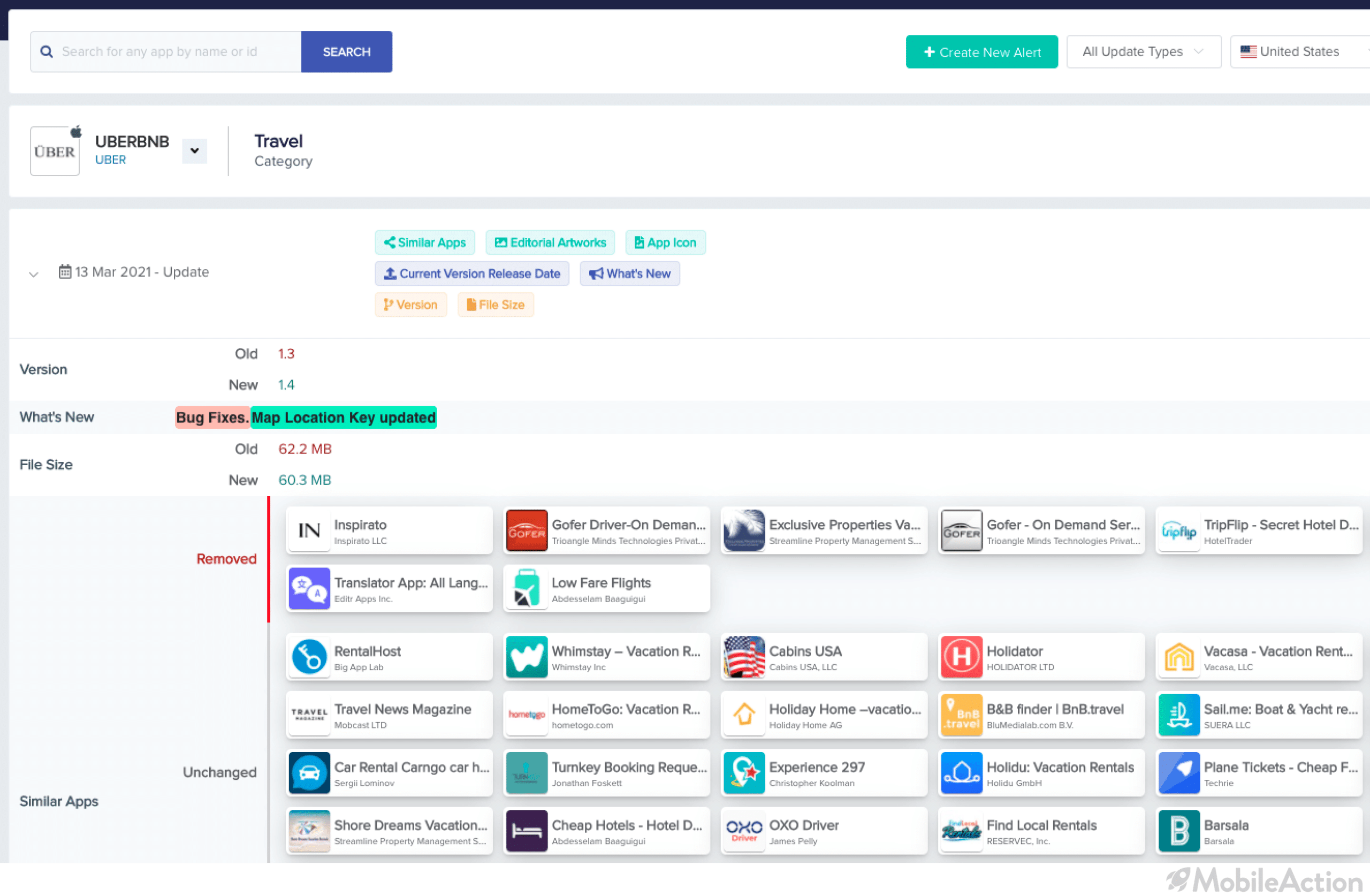
There are many more steps to be considered when conducting an ASO Audit, such as Localization. You will need to adjust your app to appeal to users who speak different languages and have different cultures. With an App Store Optimization tool like MobileAction, you can analyze how your competitors are localizing their apps, using the Localization feature.

These steps can help you start out with your growth journey, but if you’d like to experience the power of an ASO Audit tool and learn how you can boost your app using MobileAction, book a meeting with our experts.
